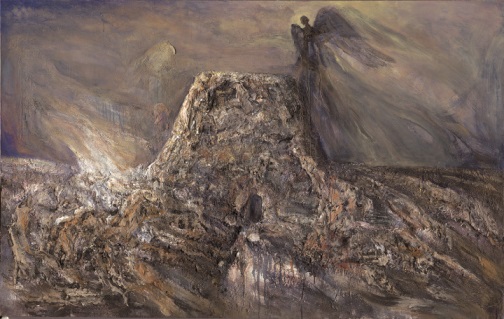Fang, Ding - VM - David Jeffrey
Ding Fang: Angel of the Fortress

Painting Transcendence
by David Jeffrey
Among the many talented painters in contemporary
In this painting, Angel of the Fortress, one of many large works in which he features evocative high desert landscapes, he suddenly was inspired to introduce a figure – not a human figure but the shadow of a transcendent presence. Worked and reworked from 2003-2009, this painting became a signature image in the midst of his myriad, heavy impasto ‘canvases’ in a series he callsMetalandscape – landscape charged with transcendent meaning. The angel here is an inhabiting spirit, not so much a guardian of the fortress and its history as a guarantor that there is something more than landscape, more than history, for one who will look for it.
Ding Fang has become a Christian and in his most recent series, One Person’s Renaissance, he explores, quite literally, faces from another time and culture in which he sees that grace has become the animating ‘life force’, radiant, and, he notes, inwardly peaceful. He has reworked many later medieval and Renaissance European portraits so as both to study their technique and to draw out further the beauty of faces which, to him, glow with serenity.
 |
 |
Ode to Light, his response to Rogier van der Weyden’s A Young Woman (ca. 1435), seems – like most of his re-workings of Renaissance portraits – actually to improve in these respects upon their model. The focus is moved upward, Rogier’s model’s jewelry has vanished and behind the serene face of the young woman are towering pinnacles of rock.
Earlier this year I was privileged to visit Ding Fang in
*******
Ding Fang: Angel of the Fortress, 2003-2009,
Ding Fang: Ode to Light, 2010-2011, 50 x70 cm, traditional ink on heavy xuan art paper and acrylic pigments.
Ding Fang (b. 1956) is Deputy Director of the Department of Studio Art at
David Lyle Jeffrey is Distinguished Professor of Literature and the Humanities at
ArtWay Visual Meditation September 7, 2014


